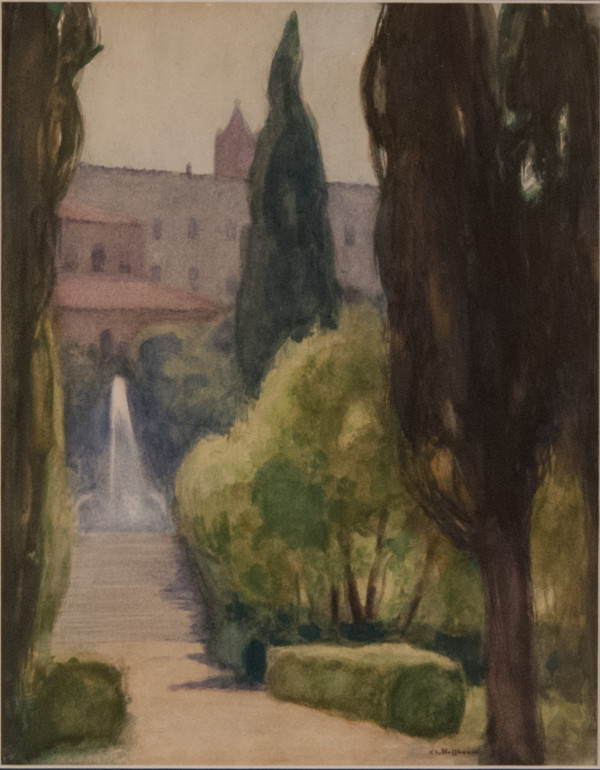-
Artist: Charles Constantine Hoffbauer (American (born in France), 1875-1957)
"Hoffbauer was born in Paris in 1875, the son of an Alsatian architect, artist and archaeologist who published Paris through the Ages." (1)
"He studied under the most famous French artists of the day and achieved widespread recognition for his work". (2)
"He studied at the Ecole des Beaux-Arts under Fernand Cormon and Gustave Moreau, rubbing shoulders with Matisse, Rouault, and Marquet, then won an Honorable Mention in the Salon of 1896 and academic prizes in 1898-99. At the Paris Universal Exposition he won a bronze medal. On a French government traveling scholarship called the Prix National du Salon, Hoffbauer discovered Italy, Greece and Egypt. Then the government purchased Champs de bataille in 1904 (Musée du Luxembourg). On a second scholarship in late 1909, Hoffbauer visited New York where he was greeted by his friend Charles Dana Gibson (1867-1944), the creator of the 'Gibson Girl.'" (1)
“[H]e fell under the spell of New York and particularly its night life. He painted several oil studies depicting people dining at night on New York rooftops in preparation for his major work Sur /es Toits which was exhibited at the Paris Salon of 1905 and is now in the collection of the National Museum in Sydney. One of these rooftop studies now hangs at the Museum of the City of New Work. Hoffbauer went on to depict many aspects of New York life, from ballrooms at the Astor Hotel to cabarets on Broadway to the streets of New York in the snow and rain.” (3)
"One of his largest paintings, Dîner sur le toit, also referred to as Roof Garden, is a nine-foot-wide painting, now in the National Gallery of New South Wales, in Sydney, Australia. At the Paris Salon of 1905, the huge painting was the talk of the town. Several studies are known (Museum of the City of New York, among others). Claude Roger-Marx wrote on it in Chronique des Arts, and Arsène Alexandre praised it in Le Figaro (both on 29 April 1905). The critics raved over the painting's "luminous beauty," its "frankness," and the "escape from tradition." We see two well-to-do couples in formal attire seated around a table on the roof garden, before skyscrapers and searchlights, an image that captures the excitement of America's Progressive Era." (1)
"Beautiful and inspiring, the Memorial Military Murals were commissioned by the Confederate Memorial Association and painted by French artist Charles Hoffbauer between 1913 and 1920. For nearly a century, they were referred to as ‘The Four Seasons of the Confederacy,’ but recent research suggests that the artist intended each to be a tribute to the major branches of Confederate military service.
“Hoffbauer left in the middle of his work to fight for his native France in World War I. When he returned, a weary soldier who now knew the horrors of the trench, he altered his plans for the murals to depict the more violent, bloody reality of war." (2)
"His mural decorations are in the Confederate Memorial Hall in Richmond, Virginia." (1)
"Hoffbauer revisited America to accept a commission for a mural (Missouri at War) in the Missouri State Capitol, and was a member of the 1937 Exposition Internationale's jury." (1)
“Hoffbauer became an American citizen in 1941 and died in Boston in 1957.” (3)
Reference:
1.Ask art staff. Charles Constantine Hoffbouer [internet]. [cited 2019 Jun 10]. Available from: http://www.askart.com/artist_bio/Charles_Constantine_Hoffbauer/20028/Charles_Constantine_Hoffbauer.aspx
2.Virginia Museum of History & Culture Staff. The Memorial Military Murals by Charles Hoffbauer [internet]. [cited 2019 Jun 10]. Available from: https://www.virginiahistory.org/exhibitions/memorial-military-murals-charles-hoffbauer
3.Mark Murray Fine Paintings Staff. Charles Hoffbauer American, 1975-1957 [internet]. New York, NY: 2019 [cited 2019 Jun 10]. Available from: https://www.markmurray.com/charles-hoffbauer-paintings-for-sale
